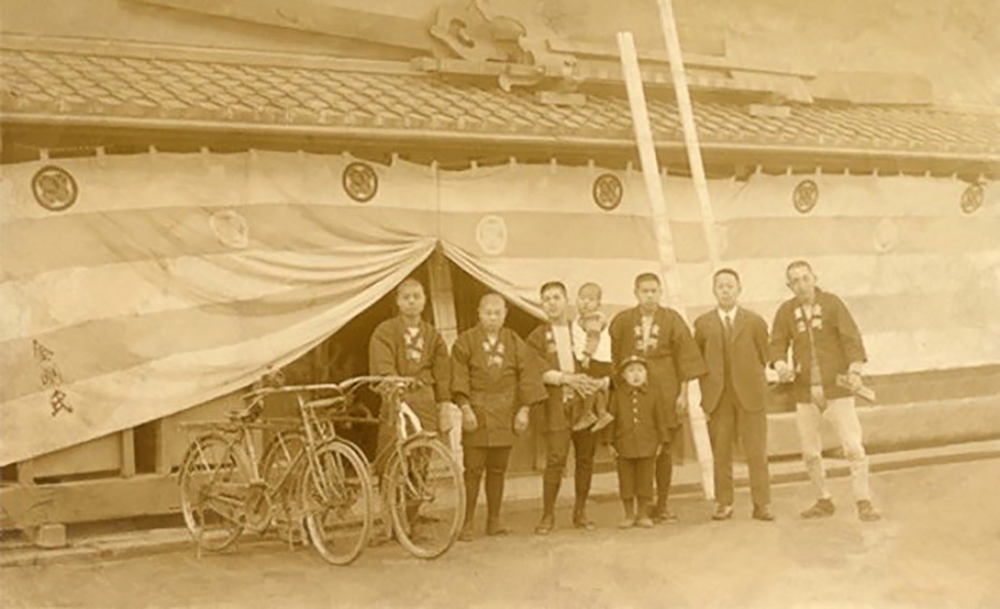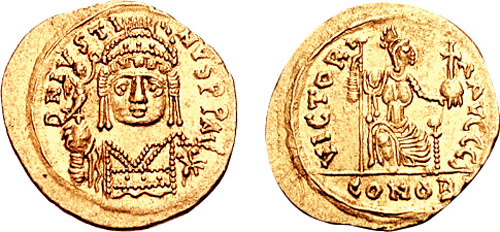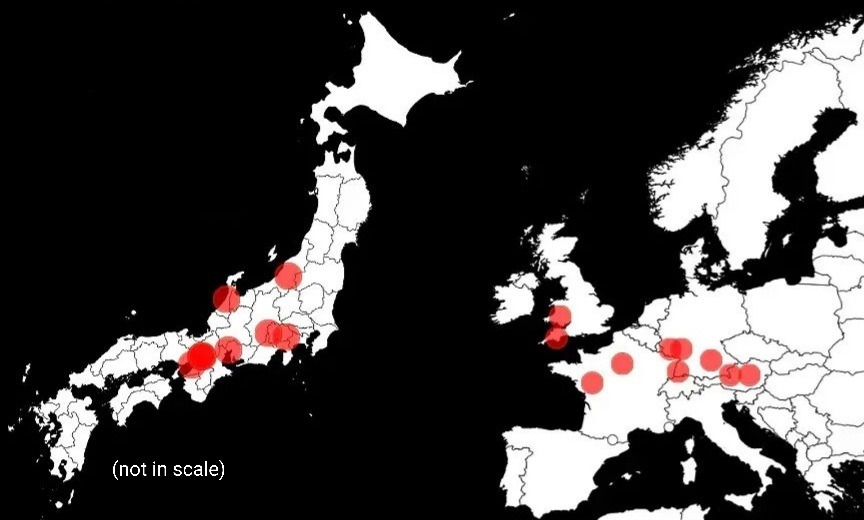|
Kongō Gumi
is a Japanese construction company. In January 2006, after falling on difficult times, it became a subsidiary of the Takamatsu Construction Group.Announcement of business transfer from Kongō Gumi Takamatsu Corporation IR Topics, 14 December 2005. Digital Chosunilbo (English Edition), 15 December 2005. History Headquartered in Osaka, Kongō Gumi was a family-owned construction company for over 1,400 years. A -long 17th century scroll traces the 40 generations back to the company's start. It has continued operation through the founder's descendants. The practice of sons-in-law taking the family ...[...More Info...] [...Related Items...] OR: [Wikipedia] [Google] [Baidu] |
Subsidiary
A subsidiary, subsidiary company or daughter company is a company owned or controlled by another company, which is called the parent company or holding company. Two or more subsidiaries that either belong to the same parent company or having a same management being substantially controlled by same entity/group are called sister companies. The subsidiary can be a company (usually with limited liability) and may be a government- or state-owned enterprise. They are a common feature of modern business life, and most multinational corporations organize their operations in this way. Examples of holding companies are Berkshire Hathaway, Jefferies Financial Group, The Walt Disney Company, Warner Bros. Discovery, or Citigroup; as well as more focused companies such as IBM, Xerox, and Microsoft. These, and others, organize their businesses into national and functional subsidiaries, often with multiple levels of subsidiaries. Details Subsidiaries are separate, distinct legal ... [...More Info...] [...Related Items...] OR: [Wikipedia] [Google] [Baidu] |
Osaka Castle
is a Japanese castle in Chūō-ku, Osaka, Japan. The castle is one of Japan's most famous landmarks and it played a major role in the unification of Japan during the sixteenth century of the Azuchi-Momoyama period. Layout The main tower of Osaka Castle is situated on a plot of land roughly one square kilometre. It is built on two raised platforms of landfill supported by sheer walls of cut rock, using a technique called burdock piling, each overlooking a moat. The central castle building is five stories on the outside and eight stories on the inside, and built atop a tall stone foundation to protect its occupants from attackers. The Main Tower is surrounded by a series of moats and defensive fortifications. The castle has 2 moats (an inner & outer). The inner castle moat lies within the castle grounds, and consists of 2 types: a wet (northern-easterly) and dry (south-westerly). Outer moat meanwhile surrounds the entire castle premise, denotes the castle's outer limits, ... [...More Info...] [...Related Items...] OR: [Wikipedia] [Google] [Baidu] |
578 Establishments
__NOTOC__ Year 578 ( DLXXVIII) was a common year starting on Saturday (link will display the full calendar) of the Julian calendar. The denomination 578 for this year has been used since the early medieval period, when the Anno Domini calendar era became the prevalent method in Europe for naming years. Events By place Byzantine Empire * Byzantine–Sassanid War: A Byzantine army under command of Maurice (''magister militum per Orientem'') invades Upper Mesopotamia, and raids on both sides of the Tigris. He deports 70,000 captives from Hyrcania to Cyprus, and installs military colonists to guard the strategic locations. * October 5 – Emperor Justin II dies after several periods of insanity. On the advice of his wife Sophia, he has raised his general Tiberius to the rank of co-emperor (''Caesar''). From December 574 he has ruled jointly with Sophia, and now succeeds them as emperor of the Byzantine Empire. Asia * Summer – Emperor Wu Di engages in mili ... [...More Info...] [...Related Items...] OR: [Wikipedia] [Google] [Baidu] |
2006 Disestablishments In Japan
6 (six) is the natural number following 5 and preceding 7. It is a composite number and the smallest perfect number. In mathematics Six is the smallest positive integer which is neither a square number nor a prime number; it is the second smallest composite number, behind 4; its proper divisors are , and . Since 6 equals the sum of its proper divisors, it is a perfect number; 6 is the smallest of the perfect numbers. It is also the smallest Granville number, or \mathcal-perfect number. As a perfect number: *6 is related to the Mersenne prime 3, since . (The next perfect number is 28.) *6 is the only even perfect number that is not the sum of successive odd cubes. *6 is the root of the 6-aliquot tree, and is itself the aliquot sum of only one other number; the square number, . Six is the only number that is both the sum and the product of three consecutive positive numbers. Unrelated to 6's being a perfect number, a Golomb ruler of length 6 is a "perfect ruler". Six is a ... [...More Info...] [...Related Items...] OR: [Wikipedia] [Google] [Baidu] |
Companies Disestablished In 2006
A company, abbreviated as co., is a legal entity representing an association of people, whether natural, legal or a mixture of both, with a specific objective. Company members share a common purpose and unite to achieve specific, declared goals. Companies take various forms, such as: * voluntary associations, which may include nonprofit organizations * business entities, whose aim is generating profit * financial entities and banks * programs or educational institutions A company can be created as a legal person so that the company itself has limited liability as members perform or fail to discharge their duty according to the publicly declared incorporation, or published policy. When a company closes, it may need to be liquidated to avoid further legal obligations. Companies may associate and collectively register themselves as new companies; the resulting entities are often known as corporate groups. Meanings and definitions A company can be defined as an "artificial per ... [...More Info...] [...Related Items...] OR: [Wikipedia] [Google] [Baidu] |
Companies Established In The 6th Century
A company, abbreviated as co., is a legal entity representing an association of people, whether natural, legal or a mixture of both, with a specific objective. Company members share a common purpose and unite to achieve specific, declared goals. Companies take various forms, such as: * voluntary associations, which may include nonprofit organizations * business entities, whose aim is generating profit * financial entities and banks * programs or educational institutions A company can be created as a legal person so that the company itself has limited liability as members perform or fail to discharge their duty according to the publicly declared incorporation, or published policy. When a company closes, it may need to be liquidated to avoid further legal obligations. Companies may associate and collectively register themselves as new companies; the resulting entities are often known as corporate groups. Meanings and definitions A company can be defined as an "artificial per ... [...More Info...] [...Related Items...] OR: [Wikipedia] [Google] [Baidu] |
Companies Based In Osaka Prefecture
A company, abbreviated as co., is a legal entity representing an association of people, whether natural, legal or a mixture of both, with a specific objective. Company members share a common purpose and unite to achieve specific, declared goals. Companies take various forms, such as: * voluntary associations, which may include nonprofit organizations * business entities, whose aim is generating profit * financial entities and banks * programs or educational institutions A company can be created as a legal person so that the company itself has limited liability as members perform or fail to discharge their duty according to the publicly declared incorporation, or published policy. When a company closes, it may need to be liquidated to avoid further legal obligations. Companies may associate and collectively register themselves as new companies; the resulting entities are often known as corporate groups. Meanings and definitions A company can be defined as an "artificial per ... [...More Info...] [...Related Items...] OR: [Wikipedia] [Google] [Baidu] |
Engineering Companies Of Japan
Engineering is the use of scientific principles to design and build machines, structures, and other items, including bridges, tunnels, roads, vehicles, and buildings. The discipline of engineering encompasses a broad range of more specialized fields of engineering, each with a more specific emphasis on particular areas of applied mathematics, applied science, and types of application. See glossary of engineering. The term ''engineering'' is derived from the Latin ''ingenium'', meaning "cleverness" and ''ingeniare'', meaning "to contrive, devise". Definition The American Engineers' Council for Professional Development (ECPD, the predecessor of ABET) has defined "engineering" as: The creative application of scientific principles to design or develop structures, machines, apparatus, or manufacturing processes, or works utilizing them singly or in combination; or to construct or operate the same with full cognizance of their design; or to forecast their behavior under speci ... [...More Info...] [...Related Items...] OR: [Wikipedia] [Google] [Baidu] |
Construction And Civil Engineering Companies Of Japan
Construction is a general term meaning the art and science to form objects, systems, or organizations,"Construction" def. 1.a. 1.b. and 1.c. ''Oxford English Dictionary'' Second Edition on CD-ROM (v. 4.0) Oxford University Press 2009 and comes from Latin ''constructio'' (from ''com-'' "together" and ''struere'' "to pile up") and Old French ''construction''. To construct is the verb: the act of building, and the noun is construction: how something is built, the nature of its structure. In its most widely used context, construction covers the processes involved in delivering buildings, infrastructure, industrial facilities and associated activities through to the end of their life. It typically starts with planning, financing, and design, and continues until the asset is built and ready for use; construction also covers repairs and maintenance work, any works to expand, extend and improve the asset, and its eventual demolition, dismantling or decommissioning. The construction ... [...More Info...] [...Related Items...] OR: [Wikipedia] [Google] [Baidu] |
List Of Oldest Companies
This list of the oldest companies in the world includes brands and companies, excluding associations and educational, government, or religious organizations. To be listed, a brand or company name must remain operating, either in whole or in part, since inception. Note however that such claims are often open to question and should be researched further before citing them. Statistics According to a report published by the Bank of Korea in 2008 that looked at 41 countries, there were 5,586 companies older than 200 years. Of these, 3,146 (56%) are in Japan, 837 (15%) in Germany, 222 (4%) in the Netherlands, and 196 (3%) in France. Of the companies with more than 100 years of history, most of them (89%) employ fewer than 300 people. In Japan, very old companies, called '' shinise'', are particularly prestigious. A nationwide Japanese survey counted more than 21,000 companies older than 100 years as of September 30, 2009. Founded before 1300 1300 to 1399 1400 to 1499 ... [...More Info...] [...Related Items...] OR: [Wikipedia] [Google] [Baidu] |
Meiji Restoration
The , referred to at the time as the , and also known as the Meiji Renovation, Revolution, Regeneration, Reform, or Renewal, was a political event that restored practical imperial rule to Japan in 1868 under Emperor Meiji. Although there were ruling emperors before the Meiji Restoration, the events restored practical abilities and consolidated the political system under the Emperor of Japan. The goals of the restored government were expressed by the new emperor in the Charter Oath. The Restoration led to enormous changes in Japan's political and social structure and spanned both the late Edo period (often called the Bakumatsu) and the beginning of the Meiji era, during which time Japan rapidly industrialized and adopted Western ideas and production methods. Foreign influence The Japanese knew they were behind the Western powers when US Commodore Matthew C. Perry came to Japan in 1853 in large warships with armaments and technology that far outclassed those of Japan, ... [...More Info...] [...Related Items...] OR: [Wikipedia] [Google] [Baidu] |
Scroll
A scroll (from the Old French ''escroe'' or ''escroue''), also known as a roll, is a roll of papyrus, parchment, or paper containing writing. Structure A scroll is usually partitioned into pages, which are sometimes separate sheets of papyrus or parchment glued together at the edges. Scrolls may be marked divisions of a continuous roll of writing material. The scroll is usually unrolled so that one page is exposed at a time, for writing or reading, with the remaining pages rolled and stowed to the left and right of the visible page. Text is written in lines from the top to the bottom of the page. Depending on the language, the letters may be written left to right, right to left, or alternating in direction (boustrophedon). History Scrolls were the first form of editable record keeping texts, used in Eastern Mediterranean ancient Egyptian civilizations. Parchment scrolls were used by the Israelites among others before the codex or bound book with parchment pages was invented ... [...More Info...] [...Related Items...] OR: [Wikipedia] [Google] [Baidu] |








